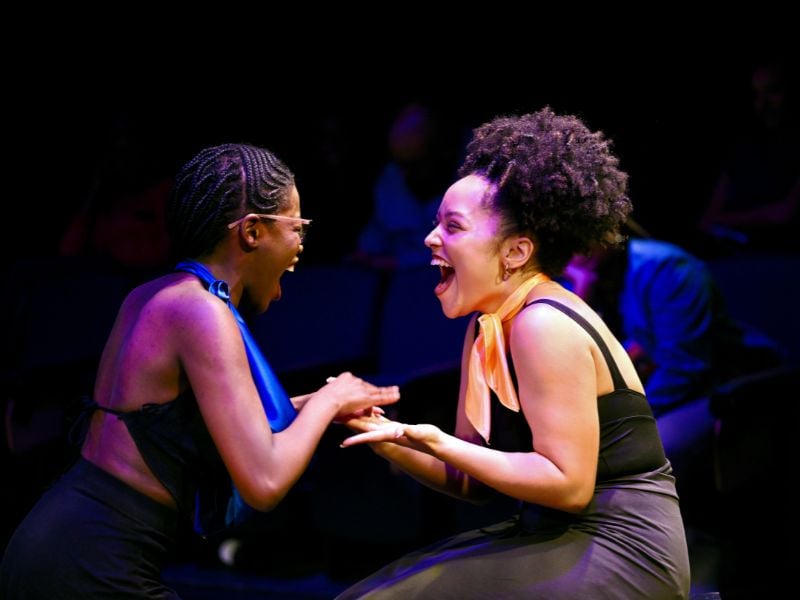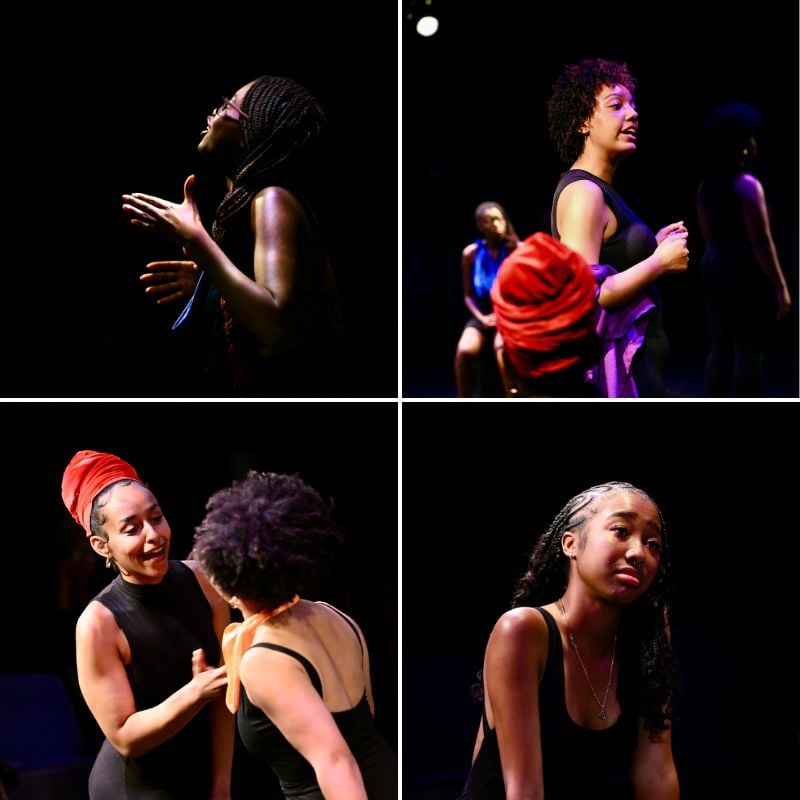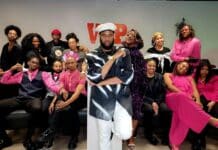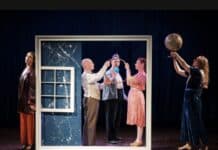This production of Ntozake Shange’s for colored girls who have considered suicide/when the rainbow is enuf, directed by Khalid Y. Long, PhD, is an engaging and affirming immersion into the 20 poems and monologs that make up a kaleidoscopic portrait of the varied experiences of African American women from girlhood to adulthood in the United States of America.

Shange attempted suicide four times over the course of her lifetime. The crux of for colored girls… looks at the dilemma of a Black woman’s task of summoning hope and maintaining the will to live and thrive in a white-supremacist and patriarchal society: a society that hates your existence.
Ntozake’s words lay out the dimensions of that box she found herself in. Her words are a message that lets other African American women know they are not alone in this struggle:
“That’s what I was discussing: how I am still alive and my dependency on other living beings for love. I survive on intimacy and tomorrow. That’s all I’ve got going.”
“Being alive AND being a woman AND being colored is a metaphysical dilemma I haven’t conquered yet.”
“Ever since I realized there was someone called a ‘colored girl’ I’ve been trying not to be that.”
“I couldn’t stand being sorry and colored at the same time. It is so redundant.”
“I had convinced myself that colored girls had no right to sorrow.”
“There was no air.”
Those last four words, unforgettable and mesmerizing, are how the segment entitled “Bo Willie Brown” begins. The line immobilizes the audience in the same way that a pin holds a butterfly in place. At the climax of this piece, a jealous, delusional, and PTSD-ravaged man drops his children from a 5th-floor window to their death while their mother watches. It synthesizes the tragic dimensions of the journey of Black Americans and the intertwined destinies of Black women with Black men in surviving forces of white supremacy.

“Bo Willie Brown” has always been the most shocking piece in the play. The clarity and focus that Mahlet Gebreyesus brings to her performance retains the poem’s power in this production. The word “motherfucker” is used so often today that it can become like just so much confetti that we brush off our ears and consciousness. When Gebreyesus addresses her estranged lover, Bo Willie Brown, she imbues the word with purpose and removes it from its use as a generic signifier of Black American–speak that it so often is in the movies.
The segment “Positive” deals with how homophobia and the resultant refusal to acknowledge bisexuality expose women to HIV/AIDS. It is an equally effective piece that has been added since the play’s original production. Chloe Lomax gives us a portrait of a woman of integrity and courage who, rather than feeling sorry for herself, pursues the truth that she needs that will allow her to face her future.
This production has been staged in the Al Freeman Jr. Environmental Theatre Space, which is a black box theater. There is no fourth wall in this intimate and elegant arena-style presentation. You can see everything from wherever you sit. The transitions between poems and monologs are as smooth as Alaga Syrup. It is a joy and a comfort to see how the youthful and energetic performers bring themselves fully and transparently to these pieces. It’s impossible not to root for them and to appreciate their commitment, energy, and focus as they work — in the words of the poet — to find God in themselves and love her fiercely.
In the first productions of for colored girls in the 1970s, the performers dressed in colored tights that evoked a kind of Martha Graham–referent dance/workshop atmosphere that had been merged with old European troubador stylings. These costumes indicated the generic and “universal” identities: Lady in Red (played in this production by Mahlet Gebreyesus), Lady in Orange (Chloe Lomax), Lady in Yellow (Me’kaili Johnson), Lady in Green (Jada Clay), Lady in Blue (Emil White), Lady in Purple (Kennedi Woods), and Lady in Brown (Kira Mukogosi). In Howard University’s production, the performers are dressed (costumes by Ellison K., Savannah Dodd, and Sharif Nelson) in a uniform black with the colors that identify them draped and wrapped intentionally and evocatively around torsos, waists, heads, shoulders, necks. This choice seems to replace the mid-20th-century, post–Civil Rights optimism of the original production with 21st-century sobriety. The production is neither nostalgic nor irrelevant.
Running Time: Approximately 90 minutes with no intermission.
for colored girls who have considered suicide/when the rainbow is enuf was performed March 28 and 29, 2025, and has remaining performances from April 1 to 5 at 7:30 pm and on April 4 at 2:00 pm (understudy run) in the Al Freeman Jr. Environmental Theatre Space (inside the Chadwick A. Boseman College of Fine Arts) on the Howard University Campus, 2455 6th Street, NW Washington, DC 20059. Tickets ($5 students, $10 general admission) are available online, in person at the box office, by emailing boxoffice.theatrearts@howard.edu, or by calling (202) 806-770.
The program can be seen here.
for colored girls who have considered suicide/when the rainbow is enuf
By Ntozake Shange
Directed by Dr. Khalid Y. Long
CAST
Lady in Red: Mahlet Gebreyesus
Lady in Orange: Chloe Lomax
Lady in Yellow: Me’kaili Johnson
Lady in Green: Jada Clay
Lady in Blue: Emil White
Lady in Purple: Kennedi Woods
Lady in Brown: Kira Mukogosi
UNDERSTUDIES
Lady in Red: Tamera McDuffie
Lady in Orange: Rayven Williams
Lady in Yellow: Jasmine Kai Young
Lady in Green: Kaci Wall
Lady in Blue: Efeoghene Rhoner
Lady in Purple: Kennedi McClure
Lady in Brown: Lauryn Cairdullo
CREATIVE TEAM
Choreographer: Lashawnda Iya Ifanike Batts
Assistant Director: Parris Brown
Stage Manager: Kaitlyn “KD”
Assistant Stage Manager: Kaia Chebiniak
Scenic Designer: Sidriel Conerly
Costume Designer: Ellison K.
Costume Designer: Savannah Dodd
Costume Designer: Sharif Nelson
Lighting Designer: Toni Rachal



